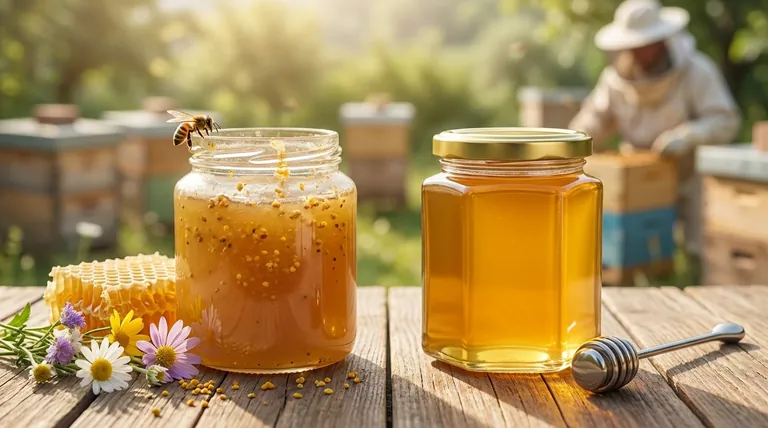The fundamental difference between raw and processed honey is a direct reflection of how much we choose to preserve the honey bee's original, intricate work. Honey bees create a complex substance rich with natural compounds. Raw honey is that substance in its most unadulterated form, while processed honey is altered for commercial appeal, often at the expense of those natural components.
The core decision is simple: choosing raw honey means valuing the unaltered product of the bee's labor, complete with its natural enzymes and pollen. Choosing processed honey prioritizes consistency, clarity, and shelf life over these delicate, natural elements.

What Bees Contribute to Honey
To understand the difference, you must first appreciate what a bee actually puts into honey. It's far more than just concentrated nectar.
The Role of Bee Enzymes
Honey bees add critical enzymes to nectar as they process it. These enzymes, like invertase and diastase, break down complex sugars and contribute to honey's unique properties, including its antibacterial effects.
These enzymes are delicate and sensitive to heat.
The Importance of Pollen Grains
As bees travel from flower to flower, they inevitably collect and transfer tiny grains of pollen into the nectar. This pollen is a source of protein and other nutrients.
The presence of pollen in honey serves as a fingerprint, identifying its floral origin and contributing to its unique color and flavor profile.
Natural Antioxidant Compounds
The nectar bees collect from plants contains a variety of antioxidants, such as flavonoids and phenolic acids. These compounds originate in the plant and are concentrated in the final honey product, playing a key role in its health-promoting reputation.
The Divergence: Raw vs. Processed
The journey from the hive to your table is where the two types of honey diverge, based entirely on the level of human intervention.
What Defines "Raw" Honey?
Raw honey is essentially honey as it exists in the beehive. It is typically strained to remove large debris like beeswax and dead bees but is not heated to high temperatures (pasteurized) or ultra-filtered.
This minimal processing ensures that the beneficial enzymes, pollen grains, and delicate compounds created or collected by the bee remain intact.
The Goals of Commercial Processing
Processed honey undergoes pasteurization (heating to high temperatures) and often ultrafiltration. This is not done to harm the product, but to achieve specific commercial goals.
Heating kills yeast cells to prevent fermentation and extend shelf life. It also slows down the natural process of crystallization, keeping the honey liquid and smooth. Ultrafiltration removes all fine particles, including pollen, to create a perfectly clear, uniform product.
Understanding the Trade-offs
Neither type of honey is inherently "bad," but they serve different purposes and offer different benefits. The choice involves clear trade-offs.
Why Choose Raw Honey?
The primary reason to choose raw honey is to consume the product in a state that is as close as possible to what the bees created. This means retaining the full spectrum of enzymes, pollen, and antioxidants.
Many also prefer the richer, more complex, and varied flavors of raw honey, which change depending on the floral source.
The Case for Processed Honey
Processed honey offers undeniable convenience. Its long shelf life, resistance to crystallization, and smooth texture make it easy to pour and use in cooking and baking without altering the consistency of a recipe.
Its clarity and uniformity are also seen as desirable qualities by many consumers who are accustomed to a standardized product.
Making an Informed Choice
Your decision should be guided by your primary goal for using honey.
- If your primary focus is potential health benefits and natural quality: Choose raw, unfiltered honey to ensure you are getting the full profile of enzymes and pollen from the bee's work.
- If your primary focus is culinary consistency and long-term storage: Processed honey provides a reliable, smooth texture and won't crystallize quickly, making it a practical choice for many applications.
Ultimately, understanding the bee's role transforms your choice from a simple preference into a conscious decision about what you value most in the final product.
Summary Table:
| Aspect | Raw Honey | Processed Honey |
|---|---|---|
| Processing | Minimally strained, not pasteurized | Pasteurized & often ultrafiltered |
| Bee Enzymes | Preserved (e.g., invertase, diastase) | Often destroyed by heat |
| Pollen | Present, contributing to flavor & nutrients | Removed for clarity |
| Antioxidants | Intact | Can be reduced |
| Texture | Naturally crystallizes | Stays liquid longer |
| Flavor | Complex, varies by floral source | Consistent, uniform |
For Commercial Apiaries & Distributors: Source the Best Honey Processing Equipment from HONESTBEE
Choosing the right equipment is crucial for producing high-quality honey that meets market demands, whether you aim to preserve the natural integrity of raw honey or achieve the consistency of processed honey. HONESTBEE supplies durable, efficient beekeeping supplies and equipment through wholesale-focused operations, helping commercial apiaries and distributors optimize their honey production.
We provide the tools you need to succeed, from extraction to bottling.
Contact HONESTBEE today to discuss your equipment needs and elevate your honey production.
Visual Guide

Related Products
- Hexagonal Glass Honey Jars with Metal Lug Caps Elegant Versatile Packaging
- Classic Drum Shaped Glass Honey Jar with Airtight Lid
- Inverted Squeezable Honey Jar with No Drip Flip Top Cap for Easy Pouring
- Plastic Honey Gate Spout with Wing Nut for Beekeeping Honey Bucket
- Natural Wood Honey Dipper for Tea Coffee and Desserts
People Also Ask
- What factors should be considered when choosing honey packaging? Optimize for Brand, Operations & Market
- What is the best way to jar honey? Preserve Quality with the Right Container
- Why is a glass jar preferred for packaging honey? Ultimate Protection for Purity & Flavor
- What are the advantages of using glass jars for honey packaging? Preserve Purity & Elevate Your Brand
- What makes raw honey more aesthetically appealing than processed honey? Discover the Beauty of Authenticity



















